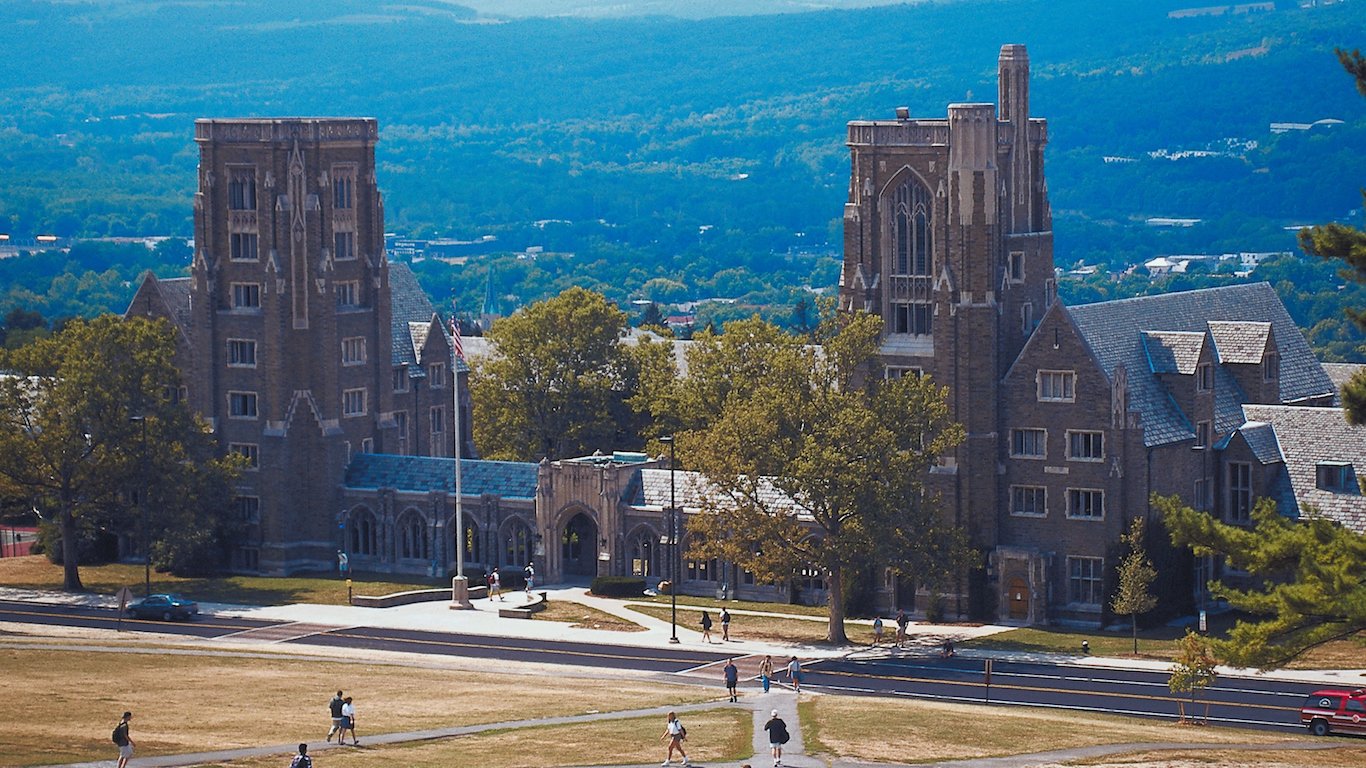Special Report
Best and Worst Cities for Women

Published:
Last Updated:

Gender inequality remains a matter of fact in the United States. Women earn roughly 80 cents on the dollar compared to their male counterparts. Many must overcome various stigma related to parenting responsibilities, gender roles, and their participation in the job market. On the other hand, women are more likely to live longer, and they are more likely to have a college degree.
These challenges and benefits play out differently across the country, and being a female in one major metropolitan area can be meaningfully different than in another, with different prospects and outlook. A job market with a severe gender wage gap can make life hard for women and girls, as can a city with widespread poverty, poor health, and subpar public education.
24/7 Wall St. reviewed multiple measures of quality of life, both those that apply to women specifically, and those that apply to populations in general, to identify the best and worst cities for women. These included each city’s gender pay gap, as well as college attainment, life expectancy, and insurance rates for women, and the share of 3- and 4-year olds enrolled in Pre-K.
Click here to see the best cities for women.
Click here to see the worst cities for women.
Click here to see our detailed findings and methodology.
Best Cities for Women

10. Bridgeport-Stamford-Norwalk, CT
> Female earnings as pct. of male: 77.8%
> Female bachelor’s degree attainment: 45.7%
> 3 and 4 yr. olds enrolled in pre-K: 66.0%
Bridgeport-Stamford-Norwalk is one of four metro areas on this list located in the Northeast. In addition to being instrumental in childhood development, pre-K programs give parents — usually the mother — the opportunity to leave their children somewhere safe during the day so they can hold a job. Connecticut spends more per pupil on pre-K programs than nearly any other state, and partially as a result, 66% of 3 and 4-year olds in the Bridgeport metro area are enrolled in preschool, a larger share than in all but six other U.S. metro areas.
Women in Bridgeport-Stamford-Norwalk also appear to be relatively healthy. Life expectancy among area women is 83.7 years, well above the 79.5 year average life expectancy of males in the area and the 80.8 year life expectancy among women nationwide.
[in-text-ad]

9. Burlington-South Burlington, VT
> Female earnings as pct. of male: 80.7%
> Female bachelor’s degree attainment: 44.8%
> 3 and 4-year olds enrolled in pre-K: 56.8%
In the Burlington metro area, women earn about 81 cents for every dollar men earn — roughly in line with the 80 cent on the dollar gender wage gap nationwide. Despite the difference in earnings, women in Burlington are more likely to have a four-year college education than area males. Some 44.8% of women in the area have at least a bachelor’s degree compared to 41.9% of area men and 30.9% of women nationwide.
Nationwide, 39.9% of management positions are occupied by women. In Burlington, women occupy 43.4% of all management roles. Despite greater representation, the typical female manager in Burlington still makes just 77 cents for every dollar earned by male managers.

8. Boston-Cambridge-Newton, MA-NH
> Female earnings as pct. of male: 79.1%
> Female bachelor’s degree attainment: 45.8%
> 3 and 4-year olds enrolled in pre-K: 61.0%
The city of Boston is home to 35 colleges and universities. The large number of higher education institutions has likely resulted in high educational attainment for both sexes. In Boston, 46.2% of men and 45.8% of women have at least a bachelor’s degree, compared to just over 30% nationwide for each men and women. Highly educated workers tend to have higher-paying jobs with better benefits, and women in Boston are among the best compensated workers in the country. The typical Boston female worker earns $52,381 annually, the fifth most among U.S. metropolitan areas.

7. Ann Arbor, MI
> Female earnings as pct. of male: 79.9%
> Female bachelor’s degree attainment: 55.6%
> 3 and 4-year olds enrolled in pre-K: 61.0%
Ann Arbor is one of only four U.S. metro areas where over half of the female population has at least a bachelor’s degree. Some 55.6% of area women have earned a four-year college degree, compared to 54.7% of area men. Despite having one of the highest female college attainment rates in the country, area women earn about 80 cents for every dollar men earn, roughly in line with the national wage gap.
Subsidized pre-K programs for 3 and 4-year olds are important for gender equality as they allow for both parents to participate in the workforce. In Ann Arbor, 61.0% of children of eligible age are enrolled in preschool, well above the 47.6% enrollment rate nationwide.
[in-text-ad-2]

6. Ames, IA
> Female earnings as pct. of male: 81.1%
> Female bachelor’s degree attainment: 49.5%
> 3 and 4-year olds enrolled in pre-K: 56.2%
Ames, Iowa ranks as one of the best U.S. metro areas for women due in large part to a higher than typical female life expectancy and a relatively large share of women with a bachelor’s degree. Life expectancy among area women is 82.7 years, and some 49.5% of women in Ames have at least a four-year college degree. Nationwide, female life expectancy is 80.8 years and only 30.9% of women have a bachelor’s degree.
While a college education is a reliable way to increase earning potential, the gender pay gap is still pronounced in Ames. Metro area women earn only about 81 cents for every dollar area men earn — roughly in line with the gender pay disparity nationwide.

5. San Jose-Sunnyvale-Santa Clara, CA
> Female earnings as pct. of male: 74.6%
> Female bachelor’s degree attainment: 47.2%
> 3 and 4-year olds enrolled in pre-K: 59.7%
The median salary among women in San Jose-Sunnyvale-Santa Clara is $60,491 a year, more than in any other U.S. metro area. Despite the higher earnings, there is still a large gender pay gap in the metro area — larger than the average nationwide. Women in the area earn only about 75 cents for every dollar area men earn, while nationwide women earn about 80 cents for every dollar men earn.
San Jose metro area parents — and mothers in particular — likely benefit from a widely accessible pre-K program. An estimated 59.7% of area 3 and 4-year-olds are enrolled in preschool, well above the comparable 47.6% national enrollment rate.
[in-text-ad]

4. Boulder, CO
> Female earnings as pct. of male: 76.6%
> Female bachelor’s degree attainment: 60.0%
> 3 and 4-year olds enrolled in pre-K: 63.3%
Adults with a bachelor’s degree tend to have better employment opportunities and overall a better sense of control over their lives. In the Boulder metropolitan area, 60% of area women have a bachelor’s degree — nearly double that of the national share and the highest of any metropolitan area. Likely as a result, Boulder women tend to earn relatively high wages — at least relative to women nationwide. The typical female worker earns nearly $50,000 a year, about $10,000 more than the national median wage for women. However, Boulder men are paid even more, at a median of $65,215 a year. The gender wage gap in Boulder, despite the women’s high wages, is larger than it is on average nationwide.

3. Iowa City, IA
> Female earnings as pct. of male: 86.3%
> Female bachelor’s degree attainment: 46.7%
> 3 and 4-year olds enrolled in pre-K: 55.5%
Some 46.7% of women in Iowa City have at least a bachelor’s degree — a considerably larger share than the 40.4% of men in the metro area. Though it is not always the case, the higher educational attainment rate of women in Iowa City may have put a dent in the metro area’s gender pay gap. Women in Iowa City earn 86 cents for every dollar men earn. Nationwide, women only earn 80 cents on the dollar.
A high preschool enrollment rate often helps support high workforce participation among mothers. In Iowa City, 55.5% of 3 and 4-year-olds are enrolled in a pre-K program, above the comparable 46.7% share nationwide.

2. San Francisco-Oakland-Hayward, CA
> Female earnings as pct. of male: 83.6%
> Female bachelor’s degree attainment: 47.1%
> Pre-school enrollment: 57.5%
Women in the San Francisco metropolitan area can expect to live to be 83.6 years old, about four years longer than their male counterparts, and longer than most other cohorts of women in general. There is another gender-based gap in San Francisco, but this one does not favor women. The typical woman earns about 84 cents for every dollar the typical male worker earns. That difference, while substantial, is not as large as the average across all metropolitan areas — the gender pay gap nationwide is about 20%. The typical women working in San Francisco still earn nearly $60,000, more than nearly any other state.
[in-text-ad-2]

1. Ithaca, NY
> Female earnings as pct. of male: 79.5%
> Female bachelor’s degree attainment: 53.9%
> 3 and 4-year olds enrolled in pre-K: 70.6%
Upstate New York’s Ithaca, home to Cornell University, is the best city for women. In Ithaca, a very high share of women are highly educated, women earn relatively high wages, and relatively few lack health insurance. An estimated 53.9% of adult women in Ithaca have at least a bachelor’s degree, the third largest share of any metro area.
Ithaca also has one of the highest rates of school enrollment among children of pre-K age, a fact that often facilitates more women participating in the workforce. While nationwide less than half of all 3 and 4-year olds attend preschool, in Ithaca more than 70% of young children are enrolled in a pre-K program. While the typical Ithaca woman is paid better than the typical woman across the U.S., she is still paid less than men in the area. Women in Ithaca earn nearly 80 cents for every dollar men earn, in line with the national gender pay gap.
Worst Cities for Women

10. Odessa, TX
> Female earnings as pct. of male: 56.7%
> Female bachelor’s degree attainment: 18.4%
> 3 and 4-year olds enrolled in pre-K: 42.7%
Many of the worst cities for women are in the South. While in Odessa the typical male worker earns $61,950 a year, more than the national median for men of $50,119, the typical female worker earns just $35,139 a year — nearly half of what area men earn and less than the median wage for women nationwide of $40,022 a year. The area’s gender pay gap — women earn 57 cents for every dollar earned by men — is the third widest in the country and persists despite the fact that women in Odessa are more likely to be college educated than men. While an estimated 14.1% of adult men in the metro area have at least a bachelor’s degree, 18.4% of adult women do.
[in-text-ad]

9. Macon, GA
> Female earnings as pct. of male: 88.2%
> Female bachelor’s degree attainment: 24.0%
> 3 and 4-year olds enrolled in pre-K: 55.8%
Women in Macon earn 88 cents for every dollar men in the area earn — a narrower gender pay gap than the national gap of 80 cents on the dollar. One reason for the relatively small gender pay gap in Macon, however, may be the low wages overall. The typical area worker earns $39,252 annually, one of the lower incomes of all metro areas.
Area women also appear to be in poor health. Life expectancy among women in the area is only 77.5 years, well below the 80.8 year life expectancy among women nationwide. Also indicative of poor health is the area’s infant mortality rate of 12.2 infant deaths for every 1,000 live births, the second highest in the nation. Poor health outcomes can often be partially explained by low insurance coverage. Some 12.6% of women in the area lack health insurance, a considerably greater share than the 8.2% uninsured rate among women across the country.

8. Florence, SC
> Female earnings as pct. of male: 75.7%
> Female bachelor’s degree attainment: 20.8%
> 3 and 4-year olds enrolled in pre-K: 41.4%
In Florence, South Carolina, women earn only about 76 cents for every dollar men earn — considerably less than the 80 cents per dollar gender pay gap nationwide. The pay gap is a reality in the metro area despite the fact that a larger share of women in Florence are college educated than men. Some 20.8% of women in the metro area have at least a bachelor’s degree compared to 18.5% of men.
Women do not appear to be in especially good health in Florence. Life expectancy among area females is only 76.8 years, one of the lowest of any U.S. metro area.

7. Lake Charles, LA
> Female earnings as pct. of male: 52.9%
> Female bachelor’s degree attainment: 24.0%
> 3 and 4-year olds enrolled in pre-K: 42.4%
In the Lake Charles metro area, an estimated 24.0% of women have a bachelor’s degree, far more than the 19.0% of men who have graduated from a four-year college. While educational attainment is higher for women than for men, the typical woman in Lake Charles earns approximately 53 cents for every dollar the typical man earns, the second largest gender pay gap of all metro areas. The median annual income for men in the metro area is $56,387, nearly twice the $29,815 figure for women. The gap is even more pronounced in management occupations, wherein the typical female manager earns just 43 cents for every dollar a male manager earns — compared to 76 cents nationwide.
[in-text-ad-2]

6. Lake Havasu City-Kingman, AZ
> Female earnings as pct. of male: 80.7%
> Female bachelor’s degree attainment: 12.0%
> 3 and 4-year olds enrolled in pre-K: 43.4%
Only 12% of women in Lake Havasu City-Kingman have a four-year college degree, the smallest such share of any U.S. metro area. Low educational attainment in a population often accounts for lower incomes, and Lake Havasu is one of only 16 U.S. metro areas where the median annual income for women is less than $30,000.
Though the gender pay gap in Lake Havasu is roughly in line with the national pay gap, the pay gap in certain professions is more pronounced. For every dollar men in managerial positions earn, women earn only 57 cents. Nationwide, women in management earn 76 cents for every dollar men earn.

5. Idaho Falls, ID
> Female earnings as pct. of male: 52.6%
> Female bachelor’s degree attainment: 25.9%
> Pre-school enrollment: 28.1%
In addition to being instrumental in childhood development, pre-K programs give parents — usually the mother — the opportunity to leave their children somewhere safe during the day so they can hold a job. Idaho is one of only a handful states that do not offer state-funded preschool, and partially as a result, only 28.1% of 3 and 4-year-olds in the state are enrolled in preschool, one of the smallest shares of any U.S. metro area.
Few parts of the country have as wide a gender pay gap as Idaho Falls does. Women earn only 53 cents for every dollar men earn across all occupations. In managerial positions, the pay gap is even wider. Women earn about a quarter of what men do in managerial positions.
[in-text-ad]

4. McAllen-Edinburg-Mission, TX
> Female earnings as pct. of male: 84.9%
> Female bachelor’s degree attainment: 17.5%
> Pre-school enrollment: 36.9%
Women in the McAllen metro area are far less likely than most to receive regular, preventative medical care. Some 30.8% of the metro area’s female population lacks health insurance, the largest share of U.S. metro areas.
Higher levels of educational attainment are linked to higher incomes, better jobs, stronger social connections, and healthier lives. In the McAllen metro area, only 60.8% of adult women have completed high school, one of the smallest such shares of any metro area and well below the 87.8% share of women nationwide.

3. Shreveport-Bossier City, LA
> Female earnings as pct. of male: 76.1%
> Female bachelor’s degree attainment: 23.2%
> Pre-school enrollment: 39.8%
In the Shreveport metro area, women earn only about 76 cents for every dollar men earn — a larger wage gap than the 80 cents women earn per dollar men earn nationwide. Maternal health also appears to be far less than optimal in Shreveport-Bossier City. For every 1,000 live births in the metro area, 12.3 infants die before their first birthday, the highest mortality rate of any metro area in the country. Greater health insurance coverage is known to reduce the incidence of adverse health outcomes. But in the Shreveport area, some 11.0% of women in the area are uninsured, a considerably larger share than the 8.2% share of women nationwide.

2. Michigan City-La Porte, IN
> Female earnings as pct. of male: 74.1%
> Female bachelor’s degree attainment: 20.3%
> Pre-school enrollment: 14.4%
Michigan City’s women are more likely than the metro area’s male population to have a bachelor’s degree. Unfortunately, the 20.3% share of women with a college degree, while greater than the 15.1% share among men, is nevertheless far below the national share of 30.9% of women with at least a bachelor’s degree. Even with this advantage in college education, women still tend to earn far less than men in Michigan City. The median annual earnings for male workers is $47,562, over $12,000, or more than 35%, higher than the typical income for a female metro area worker.
[in-text-ad-2]

1. Gadsden, AL
> Female earnings as pct. of male: 73.4%
> Female bachelor’s degree attainment: 16.9%
> Pre-school enrollment: 48.5%
Based on a range of measures related to education, health, and income, Gadsden, Alabama is the worst metro area in the country for women. Life expectancy among the Gadsden female population is only 75.3 years — well below the 80.8 year life expectancy among women nationwide. At 11.8 infant deaths for every 1,000 live births, the area’s infant mortality rate is also higher than in all but three other metro areas.
Higher levels of educational attainment are linked to better jobs, higher incomes, stronger social connections, and healthier lives. In Gadsden, only 16.9% of women have a bachelor’s degree, a little more than half the corresponding national rate of 30.9%.
Detailed Findings & Methodology
One of the best actions individuals can make to better their life and career is obtain a college education. Greater educational attainment often leads to better jobs and higher salaries. Nationwide, 30.9% of women have at least a bachelor’s degree, compared to 30.3% of men.
Despite greater educational attainment, women earn roughly 80 cents for every dollar men earn. In many U.S. cities, the gender pay gap is far worse. In Idaho Falls, for example, one of the worst metro areas for women, females earn only 53 cents for every dollar men earn, the worst pay gap of any metro area.
The gender pay gap is by no means exclusively a feature of the worst cities for women. In half the best cities for women, the gender pay gap is actually worse than it is nationwide.
For many mothers — mainly because mothers still perform most child care duties — the ability to even join the workforce may be contingent upon their children being able to go to preschool. In addition to being instrumental in childhood development, pre-K programs give parents the opportunity to leave their children somewhere safe during the day. High preschool enrollment rates can be indicative of successful preschool programs and higher shares of working mothers. The worst cities on this list tend to have lower preschool enrollment rates, while the best cities typically have a higher share of 3 and 4-year-olds enrolled in preschool.
To identify the worst U.S. metro areas for women, 24/7 Wall St. created a six part index consisting of various measures of income, educational attainment, health, and environmental factors. The index includes median female earnings as a percent of median male earnings, the share of women with at least a bachelor’s degree, the share of 3 and 4-year olds enrolled in preschool, the uninsured rate among women aged 64 and under, female life expectancy, and the infant mortality rate. Life expectancy came from the Institute for Health Metrics and Evaluation, an independent health research center affiliated with the University of Washington. Infant mortality came from the 2017 County Health Rankings & Roadmaps, a Robert Wood Johnson Foundation and University of Wisconsin Population Health Institute joint program. All other measures are for 2015 and from the U.S. Census Bureau’s American Community Survey.
A financial advisor can help you understand the advantages and disadvantages of investment properties. Finding a qualified financial advisor doesn’t have to be hard. SmartAsset’s free tool matches you with up to three financial advisors who serve your area, and you can interview your advisor matches at no cost to decide which one is right for you. If you’re ready to find an advisor who can help you achieve your financial goals, get started now.
Investing in real estate can diversify your portfolio. But expanding your horizons may add additional costs. If you’re an investor looking to minimize expenses, consider checking out online brokerages. They often offer low investment fees, helping you maximize your profit.
Thank you for reading! Have some feedback for us?
Contact the 24/7 Wall St. editorial team.